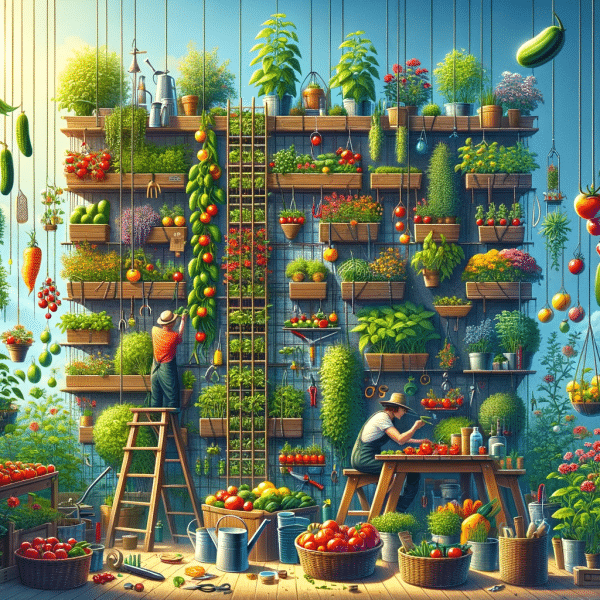
Harvesting Abundance: Tips and Tricks for Successful Vertical Gardening
Welcome to the world of vertical gardening, where nature's bounty meets sustainable living. If you're someone who dreams of self-sufficiency and a smaller carbon footprint, you're in the right place. In this article, we're about to embark on a journey through the lush, green landscape of vertical gardening, a practice that not only benefits you but also Mother Earth.
Imagine a garden that defies the limits of space, reaching for the sky, and providing you with a cornucopia of fresh produce. Vertical gardening is like a magic trick that allows you to grow plants upward instead of outward. It's gardening for those who might have limited space but boundless enthusiasm for cultivating their own food.
But what makes vertical gardening so appealing? Why is it gaining popularity among those who seek self-sufficiency and sustainability? The answer is simple: it's a smart, eco-conscious way to grow your own food, no matter where you live.
In the upcoming sections, we'll explore the ins and outs of successful vertical gardening. We'll uncover tips and tricks that will turn your small gardening space into a thriving oasis of greenery. Whether you're a beginner or an experienced gardener, there's something here for you.
So, are you ready to take the plunge into the world of vertical gardening and unlock the secrets to harvesting abundance? Let's dig in and discover how you can turn your gardening dreams into a reality.
Getting Started with Vertical Gardening
Alright, now that we're all aboard the vertical gardening train, let's talk about how to get started on this exciting journey. Think of it as the first steps into a lush, green world that you'll cultivate right at home.
The first key to successful vertical gardening is choosing the right location. It's like finding the perfect spot for a delicate flower to thrive. Most vertical gardens thrive in areas that receive plenty of sunlight, so scout your balcony, patio, or backyard for a sunny nook. If you're short on outdoor space, don't worry; there are indoor options that can work beautifully too, with the help of grow lights.
Next, you'll need a structure to support your vertical garden. This can be as simple as a trellis, a set of stacked pots, or a specially designed vertical gardening system. It's like building the frame for a work of art – sturdy and functional. Ensure that your chosen structure is secure and can bear the weight of your plants, especially when they're full-grown and heavy with produce.
Now, let's talk about soil. In the world of vertical gardening, traditional garden beds take a back seat. Instead, we use containers or pockets to hold a growing medium. Think of it as providing each plant with its own little universe. Choose a high-quality potting mix that provides good drainage – roots don't like to be waterlogged.
Choosing the right plants is crucial for a thriving vertical garden. Some veggies and herbs are particularly well-suited for vertical growth. Imagine vibrant tomatoes, aromatic basil, and cascading strawberries. It's like creating a living tapestry of colors and flavors. Research the specific requirements of the plants you choose and make sure they are compatible with vertical gardening.
Watering is a bit different in vertical gardens. It's like watering a tiered wedding cake – you want each layer to get its fair share. A drip irrigation system or a soaker hose can be your best friend here, ensuring that every plant receives the moisture it needs without overwatering or under-watering.
Pest control is another important aspect. Vertical gardens are like tempting salad bars for insects. Consider using natural pest control methods like introducing beneficial insects or practicing companion planting. It's like having nature's own security team to protect your crops.
Now that you've got the basics down, you're well on your way to becoming a successful vertical gardener.
Harvesting Your Bounty and Beyond
By now, your vertical garden is likely a thriving haven of greenery, providing you with an abundance of fresh produce. It's like having your own mini-farm right at home. But the journey doesn't end with the harvest; there are still some important aspects to consider as you enjoy the fruits of your labor.
When it comes to harvesting, timing is everything. It's like picking a perfectly ripe peach – you want to savor that moment of peak flavor. Different plants have different harvesting schedules, so keep an eye on your garden and pluck your veggies and herbs when they are at their best. This not only ensures the best taste but also encourages continuous growth.
As you gather your harvest, don't forget to share the abundance. It's like spreading happiness one tomato at a time. Share your fresh produce with friends, family, or even your local community. It's a wonderful way to connect with others and build a sense of community around your garden.
Now, what about the changing seasons? Vertical gardening allows for flexibility, even when the weather turns chilly. It's like having a wardrobe of winter coats for your plants. Consider extending your growing season with cold frames, cloches, or indoor gardening setups. With a bit of creativity, you can enjoy your garden's bounty year-round.
As you continue your journey in vertical gardening, don't forget to keep learning and experimenting. It's like tending to a garden that's always evolving. Try new plant varieties, experiment with different growing techniques, and share your experiences with fellow gardeners. The world of vertical gardening is a vibrant and ever-growing community, and there's always something new to discover.
So, there you have it – the secrets to successful vertical gardening, from choosing the right location to enjoying a bountiful harvest and beyond. Your journey has just begun, and there's a world of green adventures waiting for you. As you embark on this sustainable and rewarding path, remember that your garden is not only a source of fresh food but also a source of joy, connection, and eco-conscious living. Happy gardening!
